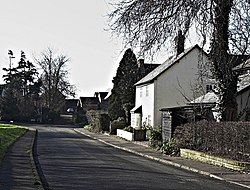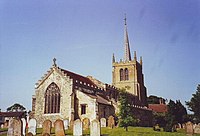Guilden Morden: Difference between revisions
Created page with '{{Infobox town |name=Guilden Morden |county=Cambridgeshire |picture=Church St and High St Guilden Morden - geograph.org.uk - 330556.jpg |picture caption=Church Street and High S…' |
No edit summary |
||
| Line 13: | Line 13: | ||
|census year=2001 | |census year=2001 | ||
}} | }} | ||
'''Guilden Morden''' is a village in the very | '''Guilden Morden''' is a village in the very south-west corner of [[Cambridgeshire]] about sixteen miles south west of [[Cambridge]] and five miles west of the border town of [[Royston, Hertfordshire|Royston]] in [[Hertfordshire]]. | ||
The history of Guilden Morden, a place never united under any one directing manor, has | The history of Guilden Morden, a place never united under any one directing manor, has resulted in a scattered, polyfocal village, a mile and a half long from Town's End to Little Green, in a parish five and a half miles long and averaging about a mile wide. | ||
Growth in the village began perhaps only with the appearance of the railway; today Guilden Morden and neighbouring [[Steeple Morden]] are served by the mainline Ashwell and Morden railway station | Growth in the village began perhaps only with the appearance of the railway; today Guilden Morden and neighbouring [[Steeple Morden]] are served by the mainline Ashwell and Morden railway station three miles to the south, near [[Steeple Morden]]. | ||
==Name== | ==Name== | ||
The name 'Morden is Old English, believed to be from ''mor dun'', meaning "moor hill", of which Guilden Morden os the "Golden" (''gylden'') village from the richness of its fields in contrast to the bare "moor" of the hills to the south in Hertfordshire.<ref>[http://kepn.nottingham.ac.uk/map/place/Cambridgeshire/Guilden%20Morden Guilden Morden], English Place-Name Society database at Nottingham University</ref> | The name 'Morden' is Old English, believed to be from ''mor dun'', meaning "moor hill", of which Guilden Morden os the "Golden" (''gylden'') village from the richness of its fields in contrast to the bare "moor" of the hills to the south in Hertfordshire.<ref>[http://kepn.nottingham.ac.uk/map/place/Cambridgeshire/Guilden%20Morden Guilden Morden], English Place-Name Society database at Nottingham University</ref> | ||
==Church== | ==Church== | ||
Latest revision as of 23:08, 15 January 2018
| Guilden Morden | |
| Cambridgeshire | |
|---|---|
 Church Street and High Street, Guilden Morden | |
| Location | |
| Grid reference: | TL279442 |
| Location: | 52°4’52"N, 0°7’59"W |
| Data | |
| Population: | 929 (2001) |
| Post town: | Royston |
| Postcode: | SG8 |
| Dialling code: | 01763 |
| Local Government | |
Guilden Morden is a village in the very south-west corner of Cambridgeshire about sixteen miles south west of Cambridge and five miles west of the border town of Royston in Hertfordshire.
The history of Guilden Morden, a place never united under any one directing manor, has resulted in a scattered, polyfocal village, a mile and a half long from Town's End to Little Green, in a parish five and a half miles long and averaging about a mile wide.
Growth in the village began perhaps only with the appearance of the railway; today Guilden Morden and neighbouring Steeple Morden are served by the mainline Ashwell and Morden railway station three miles to the south, near Steeple Morden.
Name
The name 'Morden' is Old English, believed to be from mor dun, meaning "moor hill", of which Guilden Morden os the "Golden" (gylden) village from the richness of its fields in contrast to the bare "moor" of the hills to the south in Hertfordshire.[1]
Church

The parish church of Guilden Morden is St Mary's, and has borne that dedication since at least the 15th century.
The present building consists of a chancel, aisled and clerestoried nave with south porch, and a west tower with a short spire. The oldest parts of the nave date back to the 13th century, with the majority of the building added in the 14th century. The present tower dates from the 15th century, and the present spire replaced an older one in 1972. The basin of the font is 12th century.[2]
History
The two Mordens were separated at least as long ago as 1015, when the Atheling Athelstan left an estate to the abbey at Winchester, which was Steeple Morden. The northern part of the boundary between the Mordens is marked along Cobb's Lane by an Anglo-Saxon boundary bank probably of that date.
The parish of Guilden Morden is long and thin in shape covering an area of 2,600 acres in the very south-western corner of Cambridgeshire. The parish's long western border largely follows the course of the River Rhee from the point where it rises at Ruddery Spring, and which separates it from Hertfordshire and Bedfordshire. At its southern tip, the parish meets the ancient Icknield Way (now markled by the A505) which forms the Hertfordshire border. Most of its long eastern border follows a stream that divides it from neighbouring Steeple Morden, and reaches its short northern border with Tadlow at Tadlow Bridge.[2]
The area has been occupied for at least 2000 years and probably much longer; an axehead dating from 6000 BC has been found in the parish.[3] A significant cemetery dating from Roman times has also been found in the south of the parish, containing at least 180 burials and indicating an important nearby settlement. The Anglo-Saxon village was probably built after that of its neighbour Steeple Morden.[2]
The hamlet of Odsey on the Baldock to Royston road was formerly home to a Cistercian grange. A hamlet named Redreth was listed until the 14th century, probably south of the village and perhaps deserted as a result of the Black Death.
Village life
In the village there are two pubs named the Three Tuns, which was open by 1851 and closed in 2013, and the King Edward VII. Next to the King Edward is a small village shop. The Six Bells pub, which opened next to the church before 1801, closed some time in the 1960s or 70s, and The Black Swan opened on Swan Lane in the late 19th century and closed in the 20th century. The village's other former pubs are The Pear Tree (47 New Road), The Chestnuts, The Pig and Whistle (63 High Street), The Fox, and The Black Horse (Potton Road).[2][3]
There is a primary school, named Guilden Morden Primary School. Originally founded in 1847 and opening on its current site in 1974, the school has around 120 children going from reception to year 6. The children then go on to Bassingbourn Village College in most cases. In addition the village has a pre-school.[3][4]
A fete is held each September on the recreation ground in aid of the village hall.
Outside links
| ("Wikimedia Commons" has material about Guilden Morden) |
References
- ↑ Guilden Morden, English Place-Name Society database at Nottingham University
- ↑ 2.0 2.1 2.2 2.3 A History of the County of Cambridge and the Isle of Ely, Volume 8
- ↑ 3.0 3.1 3.2 "Guilden Morden - major events". http://www.guildenmorden.gov.uk/major_events.html.
- ↑ Guilden Morden Primary School
